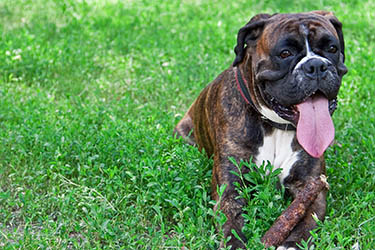What are the warning signs of periodontal disease?

The most common warning sign of periodontal disease is “dog breath.” Bad breath results from the activity of the bacteria that cause the formation of plaque, and ultimately, dental calculus (tartar).
Responsible and caring dog owners should be aware of the early warning signs of periodontal disease. If the condition is spotted and treated while in its early stages, its progression can be stopped before permanent damage and serious complications occur.
Warning signs your pet may have oral or dental issues include the following:
- bad breath
- inflamed gums that bleed easily
- gums that appear red or receding
- unusual sensitivity around the mouth
- pawing at the mouth
- missing or loose teeth
- reluctance or difficulty eating
- poor appetite
- depression
- pus leaking from around affected teeth
- drooling
- stomach upsets
If you notice any of these signs, seek veterinary advice right away.
How does your vet diagnose canine periodontal disease?

In addition to the symptoms outlined above, your vet will use a number of criteria to assess your dog’s oral health before assigning a Grade to your pet’s condition. Your dog will be examined to determine the health of his gums, along with the amount and distribution of plaque and tartar. If necessary, a more extensive exam under anesthesia may be required.
The depth and extent of “pockets” between the tooth and the gum will be measured using a calibrated probe. Pocket depth in excess of 3 mm could indicate problems below the gumline.
Finally, X-rays may be taken. Radiographs will allow your vet to see the extent of any damage that has occurred below the gumline.
Once your vet has completed his visual assessment of your pet’s condition, a Grade will be assigned. Then, a suitable course of treatment will be determined.
The treatment options for canine periodontal disease
The treatment given to your pet will depend on the periodontitis Grade that has been assigned. Your vet may elect to prescribe antibiotics for your pet several days prior to his dental procedure. Throughout the procedure, your pet will be under anesthesia.
Grade I and II treatment
Dogs with Grade I or Grade II gingivitis will be treated via a routine “prophy,” or professional prophylaxis. This procedure is similar to a scale and polish that you may have regularly at your own dentist.
Any buildup of plaque and tartar is removed from your pet’s teeth using ultrasonic or handheld scaling devices. Polishing is then carried out to remove any tiny scratches from the tooth surface. Even minor abnormalities can leave the tooth predisposed to the formation of plaque and tartar, whereas a shiny, smooth surface makes it much more difficult for plaque to accumulate. A thorough examination of every tooth and the whole oral cavity of your dog’s mouth is carried out to check for any signs of disease.
A gentle lavage is performed to remove any lingering plaque and debris that may be left in the “pockets” or below the gumline.
Plaque prevention gel, fluoride, and/or veterinary dental sealant may then be applied to provide protection for the gingival sulcus.
Grade III and Grade IV treatment
Your dog’s teeth will be scaled to remove plaque and tartar. Then, depending on the severity of your pet’s condition, your vet will opt for one or a combination of the following treatment options:
Root planing
Root planing involves the removal of residual tartar, as well as diseased dentin and cementum, and smoothing of the tooth root surface.
Subgingival curettage
This advanced procedure involves the removal of any diseased connective tissue and epithelium.
All of these procedures are highly specialized and are usually carried out by a qualified veterinary surgeon.
Gingivectomy
A gingivectomy is carried out if the dog has excess gum tissue that creates an extra-large, bacteria-friendly pseudo pocket between the gum and the tooth. Removing this excess tissue can be effective in preventing future periodontal disease.
Periodontal surgery and therapeutics
Where bone and root damage has taken place, a flap of the gum over the tooth root is opened up, allowing access to these deep structures. Removal of diseased structures and other procedures may be needed and should be performed by a veterinary dentist.
Tooth extraction
Where a tooth cannot be saved or reparative procedures are impractical, tooth extraction may be carried out.
Small breeds and brachycephalic dogs
Small breeds and brachycephalic (flat-faced) dogs, such as pugs and Pekingese, are at a greater risk of developing gingivitis and periodontal disease.
In brachycephalic breeds, the teeth are often crowded together. This can allow large amounts of plaque to accumulate, due to the hindrance of the normal cleansing mechanisms within the mouth.
In addition, flat-faced dogs are inclined to open-mouth breath, leaving them prone to dehydration of the oral cavity and thus more tenacious plaque.
Preventative measures for avoiding canine periodontal disease
In order to avoid the suffering and health problems that can be caused by periodontal disease, be sure to have your pet’s teeth and oral health checked by your vet as part of your dog’s annual health check and vaccination regimen. If your dog has been diagnosed with and received treatment for severe periodontal disease, you may need to have him checked every few months.
How canine periodontal disease is addressed
- Be sure to monitor your dog and seek veterinary advice immediately if you spot any of the classic symptoms of the condition.
- If your dog is a small breed or brachycephalic (flat-faced) dog, be sure to pay closer attention to his oral health.
- Veterinary diagnosis of periodontal disease is reached via clinical examination and X-rays.
- Grades I and II are reversible. Grades III and IV will require more extensive treatment and frequent checkups.
- Your dog will be required to undergo a general anesthetic during his treatment.
- Home care.
About Dr. James Anthony
Dr. James Anthony has been involved in veterinary medicine for
over 30 years. He is a boarded Veterinary Dentist since 1989 (Diplomate of the AVDC).
Dr. Anthony has had an extensive academic career as well, having
taught veterinary dentistry at the University of Guelph, the University of Montreal and the University of Prince Edward Island. He was also a Tenured Professor at the University of Saskatchewan as the Head of
Veterinary Oral Surgery and Dentistry.
Dr. Anthony has authored over 40 articles and book chapters, and throughout his career has lectured globally at veterinary meetings.


Working Here
Our team members are encouraged to be the best they can be... at Covetrus we believe we impact one another.
Learn MoreNews & Events
FDA Cautions Pet Owners Not to Feed Texas Tripe Inc. Raw Pet Food Due to Salmonella, Listeria Monocytogenes
The U.S. Food and Drug Administration is cautioning pet owners not to feed their pets any of the Texas Tripe brand raw frozen pet food listed below because several samples of Texas Tripe raw pet food have tested positive for Salmonella and/or L. mono.
Careers
Are you looking for a place to let your talents shine? At Covetrus, we help our practitioner customers better serve their patients and take pride in providing the best customer experience possible. Search our open positions to see our available opportunities.
Newsletter
Stay current with what’s going on with Covetrus, subscribe to receive our newsletter and email communications. Subscribers will receive the latest information in practice management, sales and marketing, animal health, and more.



-3-(1).png?sfvrsn=2d806d73_0)

Leave a comment